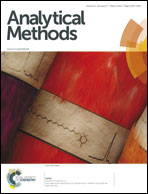HPLC/ICPMS with effluent diversion for robust and time-efficient determination of selenium metabolites in human urine
Abstract
Reversed-phase high performance liquid chromatography coupled with inductively coupled plasma mass spectrometry (RP-HPLC/ICPMS) is widely applied for the determination of major urinary selenium metabolites such as selenosugars. Urine often also contains small amounts of non-polar Se species like dimethyl selenide (DMSe) and dimethyl diselenide (DMDSe). Although these compounds are not significant quantitatively, they present considerable analytical problems because of their enhanced signals and long retention on reversed-phase columns. The use of solvent gradients to reduce the retention times of DMSe and DMDSe is usually hampered by the intolerance of ICPMS towards high loads of organic solvent. We report a simple instrumental set-up that allows application of a methanol gradient program without compromising ICPMS detection. High loads of organic solvents were prevented from reaching the ICPMS system by using a 6-port valve between the HPLC column and the ICPMS system. The combination of this experimental set-up and the developed methanol gradient provided separation of the main urinary selenium metabolites, three selenosugars and TMSe, within 7 min, and elution of non-polar selenium species DMSe and DMDSe and re-equilibration was completed within 15 minutes. The introduction of 1% CO2 in argon into the nebuliser gas flow significantly improved the stability of the system. Stability over 12 hours of measurement time tested by repeated injection (40 times) of a urine sample spiked with 3 selenosugars and TMSe gave variations in retention times of ≤0.5% and in ICPMS signal response of ≤2% for all four species. The method can be used to determine the main urinary selenium metabolites in the presence of non-polar selenium species within an overall analysis time, including re-equilibration, of 15 minutes instead of two hours for isocratic elution, offering great advantages for the analysis of large numbers of samples.


 Please wait while we load your content...
Please wait while we load your content...